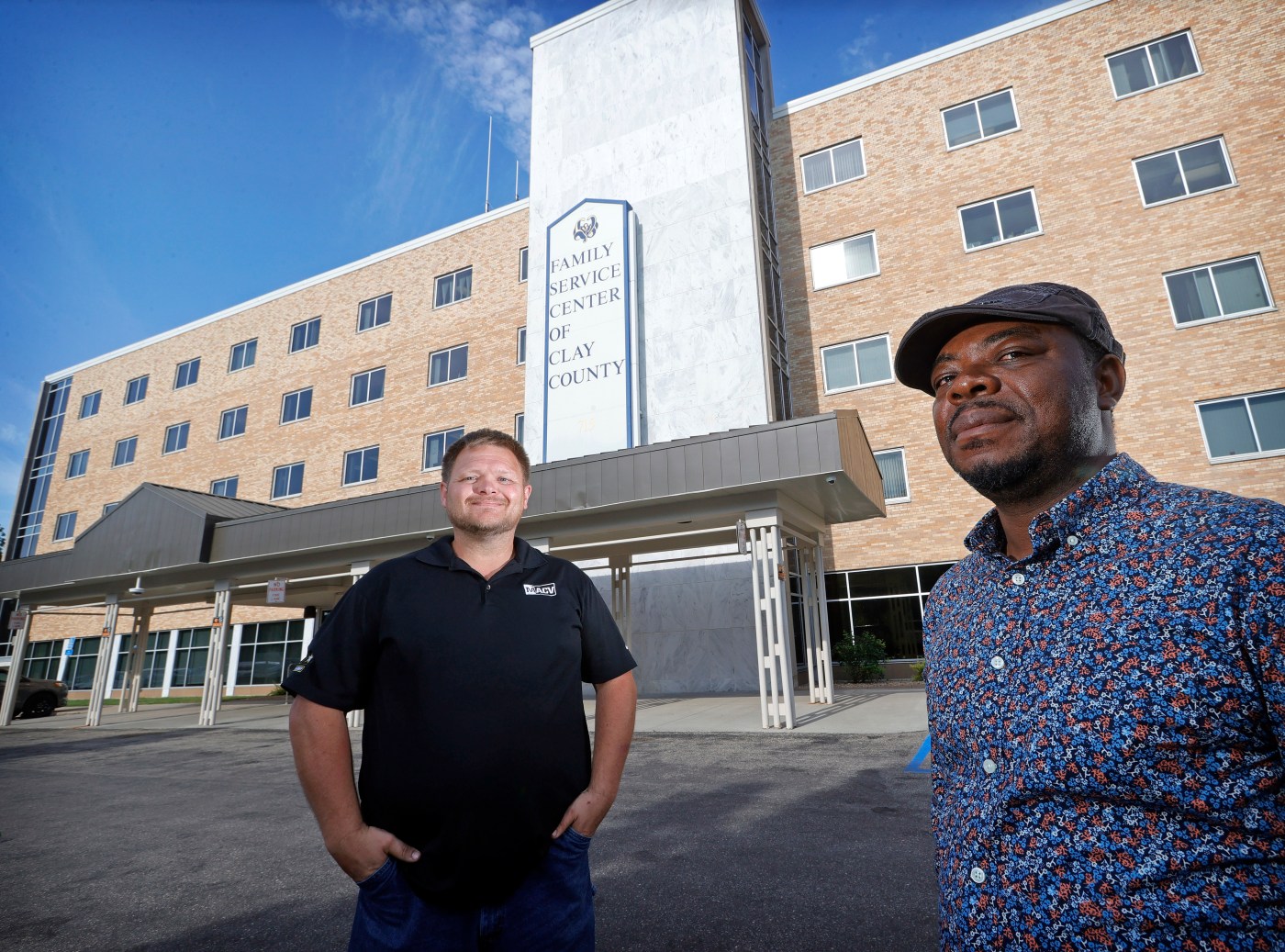
Minnesota on track for functional end to veteran homelessness in 2025
MOORHEAD — For Joseph Akerman, a job well done means a client does not come back.
Akerman works as an employment specialist for the Minnesota Assistance Council for Veterans, or MACV, a nonprofit organization working to end veteran homelessness in Minnesota.
He recounted a time a veteran’s wife came back to thank him for helping her husband secure benefits from the Department of Veterans Affairs. While happy to hear a success story, Akerman’s goal is to help veterans get the support they need to get on their feet.
“Just based on the work I do, I hope I don’t hear from you again,” Akerman said.
Akerman and colleague Thomas Avegnon, housing stabilization case manager, work from Moorhead but assist homeless veterans in more than a dozen counties in the region. With offices around Minnesota, MACV is a piece of the puzzle in a network of organizations combating veteran homelessness in the state.
In the last decade, significant progress has been made toward ending veteran homelessness in Minnesota.
In 2010, a point-in-time count identified 644 homeless veterans, said Brad Lindsay, commissioner of the Minnesota Department of Veterans Affairs. In a 2023 count, that number dropped to 336.
Minnesota has 10 regional continuums of care, which are planning bodies that coordinate housing and funding for people experiencing homelessness. So far, eight of the 10 have declared an end to veteran homelessness. The remaining two are Hennepin County and Ramsey County.
‘Pulling everybody together’
Lindsay credits the progress to efforts that started around 2014. That year, the Minnesota Department of Veterans Affairs debuted its veteran homelessness registry, a by-name list of homeless veterans in Minnesota. Around the same time, it also began leading a coordinated effort to combat veteran homelessness in Minnesota.
“One of the big roles we took as an agency was the responsibility of pulling everybody together — the federal VA, us, all those stakeholders, all those homeless providers — and coordinating it,” Lindsay said.
With the help of the registry, organizations connect with each other to discuss the needs of individual veterans.
“Then one of those organizations, in most cases, or a couple of organizations, if needed, would then kind of be assigned to take that person and start working on getting them a housing plan,” Lindsay said.
June 2024 was the first time Minnesota’s homeless veterans registry dropped below 200 people.
Barriers to housing veterans have also been identified in the last decade, like affordable and available housing, Lindsay said. In response, the Minnesota Department of Veterans Affairs developed the Veteran Temporary Emergency Housing Assistance Program, which provides funding to put veterans in a hotel or other temporary housing while starting to work on a more permanent housing plan.
The Minnesota Department of Veterans Affairs also provides landlords with financial incentives to house veterans and has awarded grants to other organizations, like MACV, to create housing specifically for veterans, Lindsay said.
Organizations working to end homelessness strive to reach the standard of “functional zero” for homelessness. The concept takes into account that people will still face homelessness, but with community systems making instances of homelessness rare and brief.
Statewide declaration goal in 2025
Hennepin County has met the benchmarks for functional zero for veteran homelessness and has submitted a request to the U.S. Interagency Council on Homelessness to make an official declaration. Ramsey County is working toward that process, as well.
Lindsay said the Minnesota Department of Veterans Affairs hopes to move toward requesting a statewide declaration in late 2025, which would make Minnesota the fourth state in the country to end veteran homelessness.
The West Central Minnesota Continuum of Care declared an end to veteran homelessness in the region in 2017.
Today, Akerman and Avegnon are part of the system preventing veterans from becoming homeless and helping homeless veterans find swift assistance.
A big part of their jobs is outreach in west-central Minnesota. When they make contact with a veteran who is homeless or facing housing instability, Avegnon works to help them stabilize that housing. Akerman focuses on the employment aspect of housing, helping people build stable careers.
The pair also connects veterans with other organizations, like the Clay County Veterans Service Office, local shelters and organizations providing mental health and addiction counseling.
MACV only serves veterans in Minnesota, but in a region bordering North Dakota, Akerman and Avegnon sometimes connect with veterans across state lines. In that case, Akerman said, they direct veterans to the North Dakota organizations that can manage their cases long-term.
“We like to have them working with whichever agency can hang on to them the longest,” Akerman said.
At present, Moorhead has around six homeless veterans, said Akerman, but the number is a moving target. Homeless veterans tend to move around often, but the homeless veteran registry and collaboration help Akerman and Avegnon keep track of the veterans they are working with.
“It’s difficult, but because we work in coordination with other organizations, one of them will find them and hand them over to us, or we will find them and direct them somewhere,” Avegnon said.
Housing for All Veterans Act
Efforts are also being made at a national level to end veteran homelessness. In July, U.S. Sen. Tina Smith, D-Minn., introduced the Housing for All Veterans Act. According to a press release from Smith’s office, the bill would provide housing vouchers to all low-income veteran households, protect veteran families from discrimination based on using a voucher and help public housing authorities electronically verify veteran status and lease rental units.
On Thursday, Aug. 8, the U.S. Department of Housing and Urban Development announced it would award $20 million in funding to public housing agencies to help cover administrative fees for the HUD-Veterans Affairs Supportive Housing program. The program helps veterans find and maintain housing.
The Clay County Housing and Redevelopment Authority was among public housing agencies awarded funding, receiving $12,770, according to HUD.
Related Articles
Toby Proctor: Are you tired of our toxic two-party system?
A Marine survived the attack on Pearl Harbor in WW2 — only to die in Saipan
Letters: ‘Socialized’ medicine? No, the V.A. delivers ‘earned care’
Christina Rost named director of Ramsey County Veterans Services
Bill Thorness: We have always owed our soldiers more


